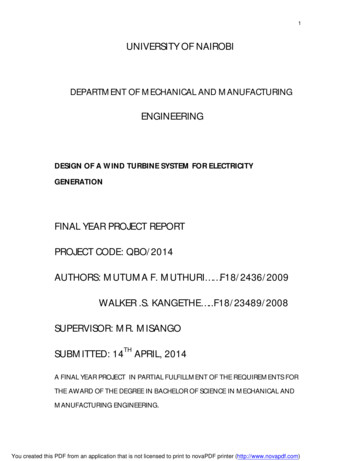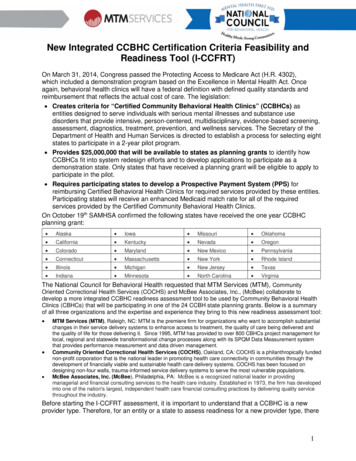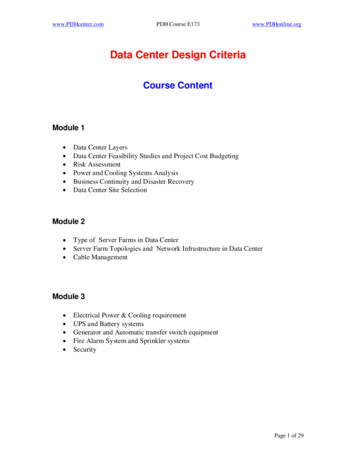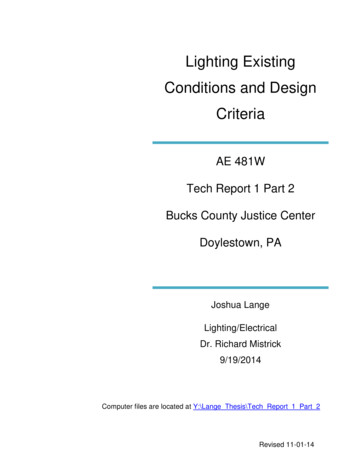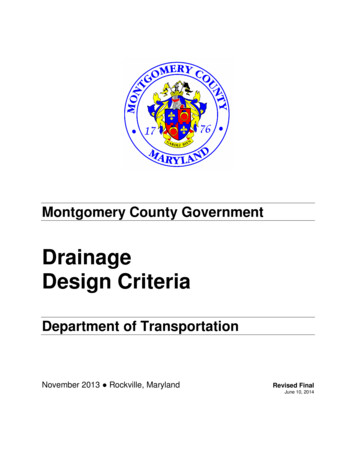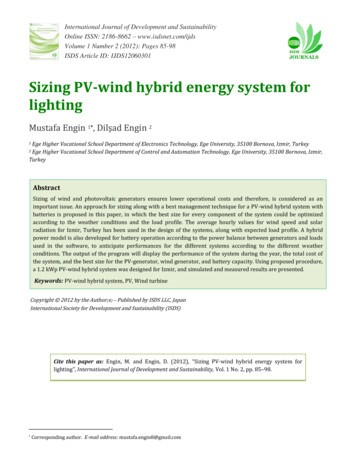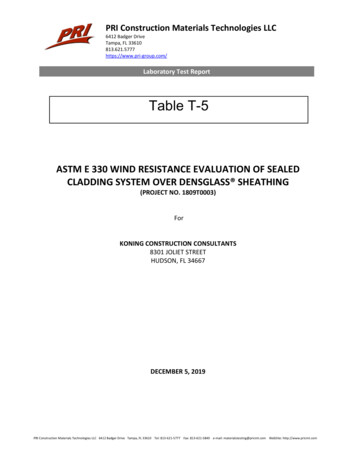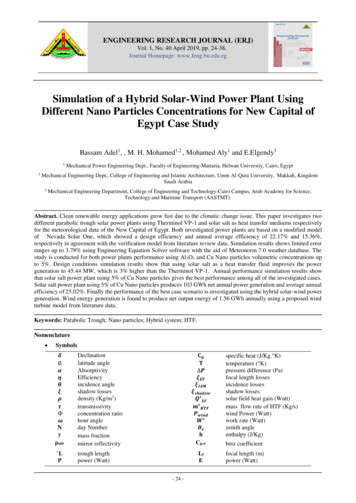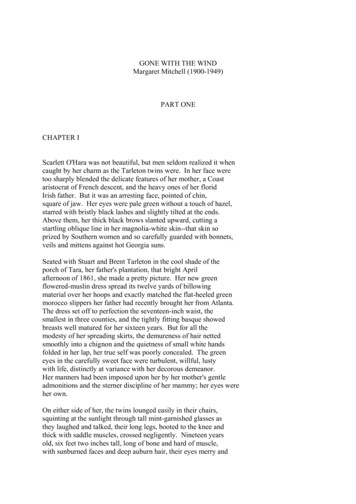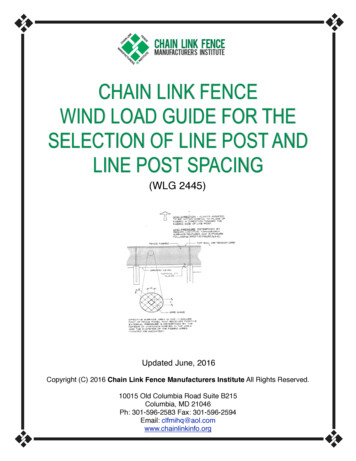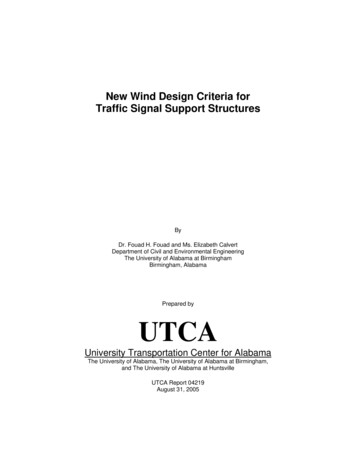
Transcription
New Wind Design Criteria forTraffic Signal Support StructuresByDr. Fouad H. Fouad and Ms. Elizabeth CalvertDepartment of Civil and Environmental EngineeringThe University of Alabama at BirminghamBirmingham, AlabamaPrepared byUTCAUniversity Transportation Center for AlabamaThe University of Alabama, The University of Alabama at Birmingham,and The University of Alabama at HuntsvilleUTCA Report 04219August 31, 2005
Technical Report Documentation Page2. Government AccessionNo.1. Report NoFHWA/4. Title and Subtitle5. Report DateNew Wind Design Criteria for Traffic Signal SupportStructuresAugust 20053. Recipient Catalog No.6. Performing Organization Code7. Authors8. Performing Organization Report No.Fouad H. Fouad and Elizabeth A. CalvertUTCA Report 042199. Performing Organization Name and Address10. Work Unit No.Department of Civil and Environmental EngineeringThe University of Alabama at Birmingham1075 13th Street South, Suite 120Birmingham, Alabama 3529411. Contract or Grant No.12. Sponsoring Agency Name and Address13. Type of Report and Period CoveredUniversity Transportation Center for AlabamaThe University of AlabamaBox 870205Tuscaloosa, AL 35487-0205Final Report: 1/1/2002 – 8/31/200514. Sponsoring Agency CodeDTSR002342415. Supplementary Notes16. AbstractThe American Association of State Highway and Transportation Officials (AASHTO) Standard Specifications forStructural Supports for Highway Signs, Luminaires and Traffic Signals have been revised in its entirety through amajor research project conducted under the auspices of the National Cooperative Highway Research Program(NCHRP Project 17-10). The new document was approved in 1999 by all state departments of transportations foradoption by AASHTO and was published in 2001. The revisions include updated provisions and criteria forextreme wind loads and new provisions and criteria on fatigue design. These provisions differ considerably fromthose in previous editions of the specifications. The impact of the new wind load and fatigue provisions on thedesign of traffic signal supports from the standpoint of safety and economy had not been studied and was the maingoal of this project. Wind load calculations and design of a span wire traffic signal structure in Alabama wereperformed using the design criteria in both the 2001 AASHTO specifications and the 1994 edition of thespecifications. The results were compared and the impact of the 2001 specifications on design of span wire trafficsignal structures in Alabama was illustrated.17. Key Words18. Distribution StatementAASHTO, traffic signal sign support, span wire, extremewind loads, structural support19. Security Classif (of thisreport)20. Security Classif. (of this page)21. No of Pages49Form DOT F 1700.7 (8-72)ii22. Price
ContentsContents . iiiList of Tables . ivList of Figures . vExecutive Summary . vi1 Introduction. 1Problem Statement .1Objective and Scope .22 Historical Perspective . 3Wind Loads.33 Wind Load Comparisons - 1994 vs. 2001 AASHTO Supports Specifications. 4Wind and Ice Maps for Alabama .4Selection of Cities .5Site Groupings .5Wind Pressure Comparison.5Summary .64 Design Comparisons for 1994 vs. 2001 AASHTO Supports Specifications . 7Structure Configuration .7Design Criteria .7Analysis.8Structure Sizes Designed Using 1994 Supports Specifications .8Structure Sizes Designed Using 2001 Supports Specifications .8Impact of Ice Loading.8Impact of Pole Deflection .9Impact of New Fatigue Provisions.9Structure Weight Changes by Site .95 Summary, Conclusions, and Recommendations. 10Summary .10Conclusions.10Recommended Future Work .106 Acknowledgements. 127 References. 13Appendix A – Tables . 15Appendix B – Figures 30iii
List of TablesTable A-1. Wind pressures for 1994 Supports Specifications .16Table A -2. Wind pressures for 2001 Supports Specifications (25-year MRI).17Table A -3. Wind sites sorted by county.18Table A -4. Wind sites sorted by wind speed and site number.20Table A -5. Wind site classifications for Alabama cities.22Table A -6. Pole and span wire sizes for group I and II load combinations considering poledeflection for 1994 Supports Specifications .22Table A -7. Pole and span wire sizes for group I, II and III load combinations considering poledeflection for 1994 Supports Specifications .23Table A -8. Pole and span wire sizes for group I and II load combinations ignoring poledeflection for 1994 Supports Specifications .23Table A -9. Pole and span wire sizes for group I, II and III load combinations ignoring poledeflection for 1994 Supports Specifications .23Table A -10. Ground line reactions for group I and II load combinations considering poledeflection for 1994 Supports Specifications .24Table A -11. Ground line reactions for group I, II and III load combinations considering poledeflection for 1994 Supports Specifications .24Table A -12. Ground line reactions for group I and II load combinations ignoring pole deflectionfor 1994 Supports Specifications .24Table A -13. Ground line reactions for group I, II and III load combinations ignoring poledeflection for 1994 Supports Specifications .25Table A -14. Pole and span wire sizes for group I, II and III load combinations considering poledeflection for 2001 Supports Specifications .25Table A -15. Pole and span wire sizes for group I, II, and III load combinations ignoring poledeflection for 2001 Supports Specifications .26Table A -16. Ground line reactions for group I, II and III load combinations considering poledeflection for 2001 Supports Specifications .26Table A -17. Ground line reactions for group I, II, and III load combinations ignoring poledeflection for 2001 Supports Specifications .27Table A -18. Pole weights for 1994 Supports Specifications .27Table A -19. Pole weights for group I, II, and III load combinations for the 2001 SupportsSpecifications .28Table A -20. Structure weight comparisons by site considering pole deflection .28Table A -21. Structure weight comparisons by site ignoring pole deflection .29iv
List of FiguresFigure B-1. Wind map: 25-year mean recurrence interval (Thom, 1968) .31Figure B-2. Basic wind speed (ANSI/ASCE 7-95, 1996) .32Figure B-3. Basic wind speed for Alabama (AASHTO, 2001) .33Figure B-4. Wind speed for Alabama, 25-year mean recurrence interval (AASHTO, 1994) .34Figure B-5. Wind pressure comparisons for 25-year mean recurrence interval .35Figure B-6. Ice loading map (AASHTO, 1994 and 2001).36Figure B-7. Ice loading for Alabama (AASHTO, 1994 and 2001) .37Figure B-8. Site nos. 1a and 1b: effective wind pressure .38Figure B-9. Site nos. 1a and 1b: ratio of wind pressures (2001 to 1994 specifications) .38Figure B-10. Site no. 2: effective wind pressure .39Figure B-11. Site no. 2: ratio of wind pressures (2001 to 1994 specifications) .39Figure B-12. Site no. 3: effective wind pressure .40Figure B-13. Site no. 3: ratio of wind pressures (2001 to 1994 specifications) .40Figure B-14. Site no. 4: effective wind pressure .41Figure B-15. Site no. 4: ratio of wind pressures (2001 to 1994 specifications) .41Figure B-16. Site no. 5: effective wind pressure .42Figure B-17. Site no. 5: ratio of wind pressures (2001 to 1994 specifications) .42Figure B-18. Site no. 6: effective wind pressure .43Figure B-19. Site no. 6: ratio of wind pressures (2001 to 1994 specifications) .43Figure B-20. Site no. 7: effective wind pressure .44Figure B-21. Site no. 7: ratio of wind pressures (2001 to 1994 specifications) .44Figure B-22. Site no. 8: effective wind pressure .45Figure B-23. Site no. 8: ratio of wind pressures (2001 to 1994 specifications) .45Figure B-24. Site no. 9: effective wind pressure .46Figure B-25. Site no. 9: ratio of wind pressures (2001 to 1994 specifications) .46Figure B-26. Site no. 10: effective wind pressure .47Figure B-27. Site no. 10: ratio of wind pressures (2001 to 1994 specifications) .47Figure B-28. 25-year MRI: range of ratios of wind pressures (2001 to 1994 specifications
AASHTO Standard Specifications for Structural Supports for Highway Signs, Luminaires and Traffic Signals, 1994 (hereafter referred to as the Supports Specifications) (AASHTO, 1994) have been totally revised based on work conducted under NCHRP Project 17-10 (Fouad et al, 1998). The project, which was completed in 1997, addressed a variety of technical topics and presented new wind maps, revised .
